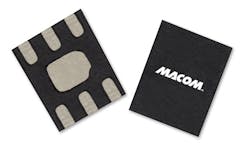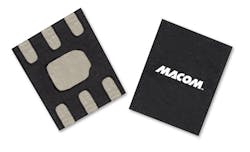Surface-Mount Mixers Extend to 33 GHz
This file type includes high resolution graphics and schematics when applicable.
From radios to test equipment, microwave mixers are still at the heart of many high-frequency systems. A trio of new discrete mixers from MACOM Technology Solutions packs outstanding frequency-conversion performance across a total frequency range of 5 to 33 GHz into miniature plastic surface-mount housings. The trio consists of the high-linearity model MAMX-011021, the image-reject mixer model MAMX-011022, and the low-noise active mixer model MAMX-011023 (see photo).
The high-linearity model MAMX-011021 mixer provides the widest frequency coverage of the three, with an RF range of at 5 to 33 GHz and an LO frequency range of 3 to 39 GHz; it is well suited for such applications as high-bit-rate digital transmitters and receivers. It offers an intermediate-frequency (IF) range of DC to 5 GHz by way of approximately 9-dB conversion loss. The mixer is based on a single-ended cold (passive) field-effect-transistor (FET) configuration with diplexer. It achieves an input third-order intercept point (IIP3) of +22 dBm to maintain low distortion over its wide frequency range and in myriad signal-power conditions.
While the model MAMX-011021 mixer does not require bias voltage, it can be used with positive bias voltage of less than +1 VDC to reduce the LO drive requirements. The mixer can operate in frequency upconversion and downconversion applications, and a pair of the mixers can be set in a quadrature configuration for image-reject mixing.
The model MAMX-011022 passive image reject mixer is targeted at medium-data-rate, long-haul, low noise systems, and can be used for both frequency upconversion and downconversion (although it is primarily designed for downconversion purposes). This tiny mixer can operate without a bias source; it spans an RF range of 5 to 28 GHz, an LO range of 2 to 28 GHz, and an IF range of DC to 5 GHz. It provides image rejection of 18 dB with typical conversion loss and noise figure of 12 dB measured at test frequencies of 6, 18, and 26 GHz.
The mixer integrates a 90-deg. balun into a balanced subminiature mixing core to achieve its wideband frequency coverage. Model MAMX-011022 handles RF inputs to +15 dBm and exhibits typical return loss of 8 dB at all three (RF, LO, IF) mixer ports. The mixer’s input 1-dB compression point is typically +15 dBm at 18 GHz. By supplying optional DC bias of +3 VDC at 2 mA, the RF linearity can be optimized.
Finally, model MAMX-011023 is a low-noise active mixer that maintains typical noise figure and conversion loss of only 7 dB for input signals through 23 GHz. It features an RF range of 4 to 23 GHz, an LO range of 4 to 23 GHz, and an IF range of DC to 8 GHz. Because this is an active mixer, it requires bias of +3 VDC and 15 mA. The mixer integrates a FET gain element with LO and RF driving the same pin, employing transconductance mixing to achieve the low noise figure. Model MAMX-011023 can be used for lower-sideband (LSB) or upper-sideband (USB) mixing, and can operate with relatively low LO levels (less than 0 dBm).
All three of these surface-mount mixers are supplied in industry-standard plastic TDFN packages measuring a mere 1.5 × 1.2 mm. All three mixers are designed for operating temperatures from -40 to +85°C.
MACOM Technology Solutions, Inc., 100 Chelmsford St., Lowell, MA 01851; (800) 366-2266, (978) 656-2500
This file type includes high resolution graphics and schematics when applicable.
About the Author
Jack Browne
Technical Contributor
Jack Browne, Technical Contributor, has worked in technical publishing for over 30 years. He managed the content and production of three technical journals while at the American Institute of Physics, including Medical Physics and the Journal of Vacuum Science & Technology. He has been a Publisher and Editor for Penton Media, started the firm’s Wireless Symposium & Exhibition trade show in 1993, and currently serves as Technical Contributor for that company's Microwaves & RF magazine. Browne, who holds a BS in Mathematics from City College of New York and BA degrees in English and Philosophy from Fordham University, is a member of the IEEE.


